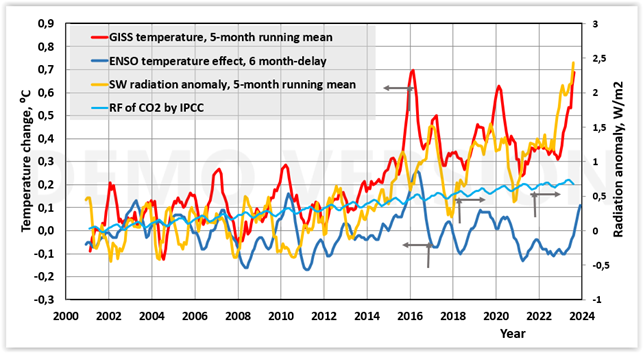
The media has reported record-high temperatures for the recent months. Climate change has been blamed, which the IPCC claims is solely due to the increase in greenhouse gases. Nowhere has there been any news that the Earth received about 3 W/m2 more solar radiation in August 2023 than in the first half of 2000. According to the IPCC, anthropogenic or human-induced radiative forcings in 2019 were 2.7 W/m2, which caused a temperature increase of 1.27 °C compared to 1750. According to IPCC science, the impact of solar radiation was a more significant factor in summer than greenhouse gases in summer 2023.
The increase in solar radiation received by the Earth has not been due to changes in solar activity but to changes in the atmosphere. The most likely reason is a decrease in the amount of low cloud cover. The overall situation can be seen in the figure, which shows the measured temperature and the change in solar radiation from 2001 to August 2023.

The red curve is the global temperature of the Earth. The yellow curve is the change in solar radiation received by the Earth, calculated as the difference between the solar radiation received by the Earth and the radiation reflected by the Earth. These results are based on accurate measurements from NASA’s CERES satellites. The green curve is the radiative forcing change caused by carbon dioxide calculated according to the IPCC. The temperature effect of the ENSO effect (El Nino / La Nina) is a blue curve.
It is easy to conclude from the figure, even when viewed with an eye, that changes in global temperature, especially after 2014, are caused by changes in the amount of solar radiation absorbed by the Earth and the ENSO effect. Carbon dioxide does not affect monthly temperature changes. El Nino, which has been developing over the past summer, has yet to affect global temperatures, as its global temperature impacts come with a delay of about six months. The high temperatures of recent months are solely due to a sharp increase in solar radiation, the values of which are currently known only until August 2023.
During the temperature pause from 2000 to 2014, fossil carbon dioxide emissions were 126 gigatons of carbon (GtC), which is 31% of all carbon dioxide emissions since 1750, but during that time greenhouse gases were unable to raise the temperature, although IPCC models suggest that there should have been an increase of 0.4°C. The most popular explanation was that the increase in heat caused by the greenhouse effect disappeared into the deep oceans, although this is not possible. The question is why the IPCC or NASA do not report on the recent significant change affecting the climate. The reason is probably that there is not even a bad explanation for this. Except for the fact that the warming is now caused by solar radiation and not by man. The Earth gets 99.97% of its energy from the sun.
